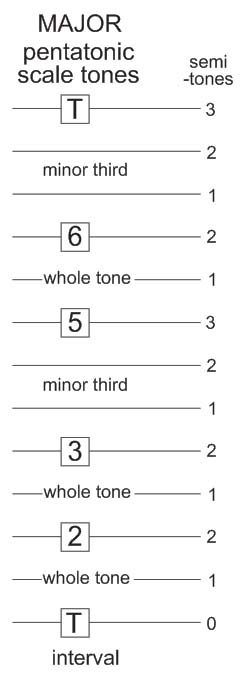Musicarta Pentatonics Workbook
'Ambling Around'
The Major Pentatonic Scale, Part One
This Musicarta Pentatonics Workbook module teaches a catchy riff that uses the three all-white-key major pentatonic scales: C, F and G.
First, watch the final video performance to see where we're heading.
Learn to sing the up-and-down scale pattern used in the piece as soon as you can.
Counting the major pentatonic scale
Here are the three pentatonic keyboards you will be learning in this module.
The keyboards are marked up with the pentatonic shorthand: T (for tonic), second, third, fifth, sixth (the five major pentatonic scale tones) and the tonic again at the octave.

The C keyboard does not line up with the F and G keyboards following


|
Here is the major pentatonic ladder diagram showing the steps (intervals) between the major pentatonic scale tones. You notice that, just like in the minor pentatonic scale (Module One), there are only whole tone and minor third steps. This is one reason why the pentatonic scales are so useful: they miss one the fourth and seventh (major) scale tones which are a semitone from their neighbours, and therefore more likely to clash, sound-wise. Live with this diagram! You want to hear to a major pentatonic scale in your head when you see it! |
 |
F major pentatonic
Here's a video to guide you through counting the F major pentatonic scale. Refer back to the keyboard and ladder diagrams continually.
G major pentatonic
Because both the F major and G major pentatonic scales are all-white-key scales, we can just move the hands one key to the right and we have the G major pentatonic scale 'for free'.
Go through the counting again, though. It won't sink after just once!
C major pentatonic and top F
The same counting procedure for the C major and top F pentatonic scales. You should be hearing the soundtrack of this video in advance now!
Adding the rhythm
Now we add some rhythm, to our up-and-down major pentatonic outing.
Most music is quite simple; it's the rhythm that makes it catchy. This is especially true of popular music, so please do clap-and-count as requested, no matter how odd or 'silly' it feels.
There's a Musicarta motto: "If you can say it, you can play it!" Here's the counted rhythmic pattern.

Now play the pattern in rhythm in G.
Now play the pattern in rhythm in C and in a top F position (an octave higher).
You see the pentatonic keyboards in these examples marked up
P P P M P P M P
This "Play one, miss one, play one" mark-up shows you where the gaps in what would be the major scale are: the fourth and seventh notes are missed out.
Because the C, F and G major pentatonic scales are all-white-key scales, you can simply count (and miss out) white keys.
If you know your other major scales, you can use this formula to skip the fourth and seventh scale tones and find the major pentatonic scale in any key.
A whole chorus
Now to play a whole chorus.
The difficulty in a piece like this is usually in jumping between hand positions, so rather than just throwing yourself at it, we rehearse the jumps first.
In proper musical lingo, you go up a second, up a fourth, and up a fourth again.
(This simplified chorus plays 'the pattern' in the top F position. You learn the long, descending ending in the next module.)
Here's a play-along chorus with accompaniment.
If you need to revisit the jumps issue (be honest!), making sure your left hand starts off to the new hand position as soon as it's finished playing its notes.
And here's a 'karaoke' chorus which shows your performance, but without any sound.
This is your module target performance.
Be sure you can play it dependably before going on to the next module.
|
OUT NOW! |
THE MUSICARTA BEAT & RHYTHM WORKBOOK At last! An effective approach to keyboard rhythm & syncopation skills. Learn more! |
ONLY $24.95! |
|
THE MUSICARTA PENTATONICS WORKBOOK video course Home/Index pages The Pentatonic Scales
Practice Patterns
Melody Work and
Playing by Ear
Pentatonic Riffs
and Diaries - Minor Pentatonic Major Pentatonic
Chromatic Minor
Chromatic Major
Pre-video Pages
Pentatonics videos
Archive Pages
|
The MusicartaA methodical approach to keyboard syncopation for
|
PUBLICATIONS
exciting keyboard
creativity courses
CHORDS 101
WORKBOOK

~HANON~
video course

Musicarta
Patreon
PENTATONICS
WORKBOOK
video course

Creative Keyboard
video course

BEAT AND RHYTHM
WORKBOOK

- Volume 1 -

12-BAR PIANO
STYLES WORKBOOK

MUSICARTA MODES
WORKBOOK

PIANO STYLE

CANON PROJECT
video course

VARIATIONS
video course


- Piano Solo -
video course

- Piano Solo -


YouTube playlists





 THE LOGO
THE LOGO
